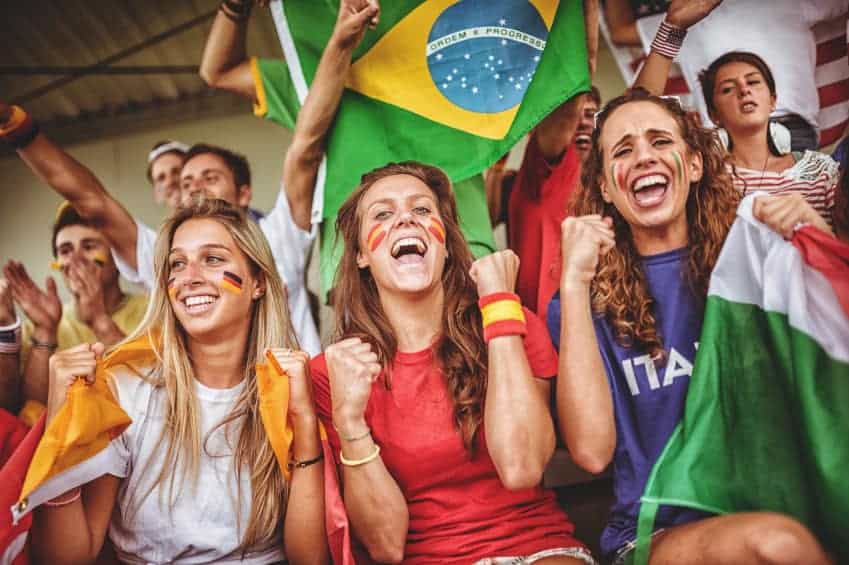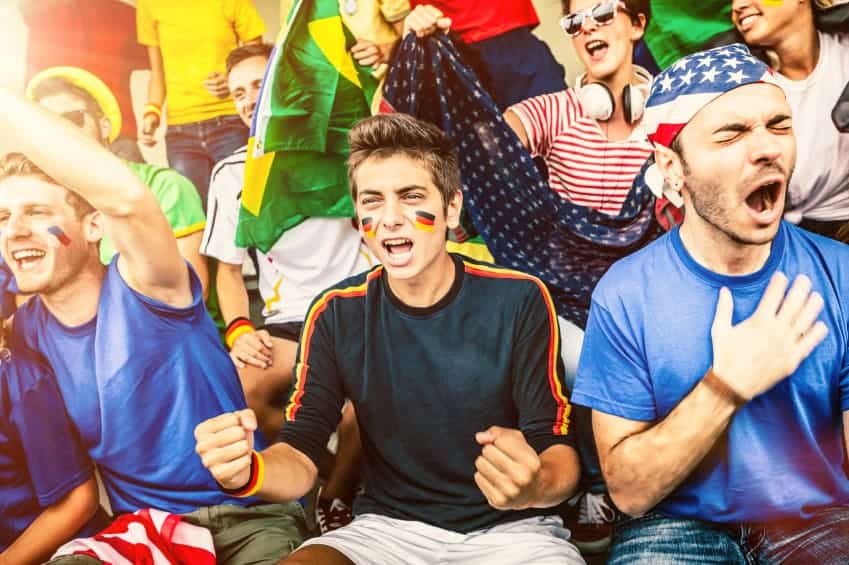Dempsey scores! Altidore is hurt, but it’s a tight hamstring, not torn. The U.S. must get possession and keep it going forward. Great U.S. goalie and bad shooting from Ghana. It evened up in the last eight minutes. Then John Brooks! Storms could roll in, and if the ocean doesn’t want Natal, the jungle might take it back. It could have been heartbreak at the World Cup, but then the clock ran out. Can you believe it? U.S.A. Unfreakingbelievable! Revenge is sweet.
It is a beautiful game. In the face of such glory, who can talk World Cup business? Ice water on the head for everyone. Deep breath, and on to marketing.
Cars, beer, shoes and chocolate popping candy – World Cup fever is a marketer’s dream. What can’t you sell? But beneath the glassy surface lies a different world. It’s not Iran vs. Nigeria or the U.S. vs. Ghana. It’s FIFA, alone on the field. And if you are into the funky and creative world of ambush marketing, you could find yourself in jail.
The Law of the World Cup
Feel good slogans and national pride aside, the World Cup is run not for the public good, but for the benefit of private parties, principally, Federation Internationale de Football Association (FIFA), the Local Organizing Committee and the Brazilian Confederation of Football. The business of the World Cup 2014 is regulated by the World Cup Law, which reads like the kind of contract only someone with a very valuable commodity might be able to negotiate. This is not a contract, however. It is legislation, duly decreed by the National Congress and sanctioned by the President of the Republic of Brazil, and therein lies the problem.
Much of the preparation leading up to the World Cup has been controversial. John Oliver, in a typically entertaining rant, has described the stadium in Manaus, where four games will be played and which has no use thereafter, as the world’s most expensive bird toilet. Brazil bans alcohol at soccer matches in an effort to reduce deaths, certainly an exercise in prudence. That law has been amended, however, to permit sales at the World Cup, which has Budweiser as a sponsor.
Chapter II of the Law contains some of the strongest language, regulating marketing and generally protecting FIFA’s trademarked symbols, granting them the special status of “notoriously recognized” and “high importance,” demarcations that confer extra legal protection. Chapter VIII actually criminalizes certain conduct, including ambush marketing by association and ambush marketing by intrusion.
World Cup Advertising
Global advertising is expected to move into the half trillion dollar zone with the World Cup this summer. FIFA’s major partners, including Adidas, Coca-Cola, Hyundai Motor Group, Sony and Visa reportedly pay $25-50 million per year. Sponsorship costs a little less, in the range of $10-25 million. Even if your small business is not yet ready for this kind of buy, you cannot have missed the marketing power of futbol. You might even decide to move some of those short-sleeved shirts off the Father’s Day clearance table by tossing in a soccer ball or two.
What is Ambush Marketing?
These are practices at the very edge of commercially acceptable, whether on one side of the line or the other. Ambush marketing is a strategy through which advertisers attempt to associate a product with an event or team or player in a way that misleads the public about a connection that does not actually exist. (It can even be used in reverse, as was done a decade ago with the political street theatre “Billionaires for Bush.”) More to the commercial point, however, it involves not paying the fee. Scholars of ambush marketing generally divide it into three types: ambush by association, ambush by intrusion and opportunistic ambush.
Ambush by association sometimes involves blatant misappropriation of protected trademarks. It can be far more subtle, however, perhaps involving no more than a mention of Brazil, an image of wildly cheering fans at a non-specific sporting event or a soccer ball among the shirts.
Ambush by intrusion tends to be more theatrical and at least through the 2006 and 2010 World Cups seems to have involved an ongoing rivalry between the Dutch and the Bavarians, sometimes involving lovely models disguised as fans for the other side, and sometimes involving bright orange lederhosen. At the very least, it results in ejection from the game. Jail time is a new twist.
Opportunistic ambush is the viral image or slogan, along the lines of the Zippo lighter re-lighting the Olympic flame during the Sochi 2014 Winter Olympics. Oreo did much the same after the power outage at the 2013 Super Bowl caused a 34-minute delay with “You can still dunk in the dark.” It’s witty, tongue-in-cheek and perfectly legal.
The matches have nearly another month to roll on. The ladies in lederhosen have yet to appear, so we cannot tell if FIFA is prepared to take draconian steps to protect its commercial rights.
At the end of July, however, the circus will leave town, or more specifically the 12 locations throughout Brazil where matches were held. FIFA and its related associations, partners and sponsors will count the cash and look onward to Russia in 2018 and then to Qatar for 2022, where troubling allegations of slave labor are already emerging.
Will FIFA continue to be able to negotiate the kinds of deals that put the machinery of government at the service of private enterprise? Capitalism does not oppose this, except and until the benefit for private enterprise comes at the expense of public good. Neither of the upcoming venues has an encouraging track record in this regard.
It may be time to distinguish more clearly between the beautiful game, the laudable goals of national pride and peaceful international competition, on one hand and the big business of World Cup, on the other. Whether the latter deserves governmental support may depend on the balance between protecting free expression and commercial rights. It also matters what is left for the host after the party is over.






![Law in the Digital Age: Exploring the Legal Intricacies of Artificial Intelligence [e323]](https://www.pashalaw.com/wp-content/uploads/2023/11/WhatsApp-Image-2023-11-21-at-13.24.49_4a326c9e-300x212.jpg)
![Unraveling the Workforce: Navigating the Aftermath of Mass Layoffs [e322]](https://www.pashalaw.com/wp-content/uploads/2023/07/Untitled-design-23-300x212.png)
![Return to the Office vs. Remote: What Can Employers Legally Enforce? [e321]](https://www.pashalaw.com/wp-content/uploads/2023/01/Pasha_LSSB_321_banner-300x212.jpg)
![Explaining the Hans Niemann Chess Lawsuit v. Magnus Carlsen [e320]](https://www.pashalaw.com/wp-content/uploads/2022/10/LAWYER-EXPLAINS-7-300x169.png)
![California v. Texas: Which is Better for Business? [313]](https://www.pashalaw.com/wp-content/uploads/2021/07/Pasha_LSSB_CaliforniaVSTexas-300x212.jpg)
![Buyers vs. Sellers: Negotiating Mergers & Acquisitions [e319]](https://www.pashalaw.com/wp-content/uploads/2022/06/Pasha_LSSB_BuyersVsSellers_banner-300x212.jpg)
![Employers vs. Employees: When Are Employment Restrictions Fair? [e318]](https://www.pashalaw.com/wp-content/uploads/2022/05/Pasha_LSSB_EmployeesVsEmployers_banner-1-300x212.jpg)
![Vaccine Mandates Supreme Court Rulings [E317]](https://www.pashalaw.com/wp-content/uploads/2022/02/WhatsApp-Image-2022-02-11-at-4.10.32-PM-300x212.jpeg)
![Business of Healthcare [e316]](https://www.pashalaw.com/wp-content/uploads/2021/11/Pasha_LSSB_BusinessofHealthcare_banner-300x212.jpg)
![Social Media and the Law [e315]](https://www.pashalaw.com/wp-content/uploads/2021/10/WhatsApp-Image-2021-10-06-at-1.43.08-PM-300x212.jpeg)
![Defining NDA Boundaries: When does it go too far? [e314]](https://www.pashalaw.com/wp-content/uploads/2021/09/Pasha_LSSB_NDA_WordPress-2-300x212.jpg)
![More Than a Mistake: Business Blunders to Avoid [312] Top Five Business Blunders](https://www.pashalaw.com/wp-content/uploads/2021/06/Pasha_LSSB_Blunders_WP-1-300x212.jpg)
![Is There a Right Way to Fire an Employee? We Ask the Experts [311]](https://www.pashalaw.com/wp-content/uploads/2021/02/Pasha_LSSB_FireAnEmployee_Website-300x200.jpg)
![The New Frontier: Navigating Business Law During a Pandemic [310]](https://www.pashalaw.com/wp-content/uploads/2020/12/Pasha_LSSB_Epidsode308_Covid_Web-1-300x200.jpg)
![Wrap Up | Behind the Buy [8/8] [309]](https://www.pashalaw.com/wp-content/uploads/2020/11/Pasha_BehindTheBuy_Episode8-300x200.jpg)
![Is it all over? | Behind the Buy [7/8] [308]](https://www.pashalaw.com/wp-content/uploads/2020/09/iStock-1153248856-overlay-scaled-300x200.jpg)
![Fight for Your [Trademark] Rights | Behind the Buy [6/8] [307]](https://www.pashalaw.com/wp-content/uploads/2020/07/Fight-for-your-trademark-right-300x200.jpg)
![They Let It Slip | Behind the Buy [5/8] [306]](https://www.pashalaw.com/wp-content/uploads/2020/06/Behind-the-buy-they-let-it-slip-300x200.jpg)
![Mo’ Investigation Mo’ Problems | Behind the Buy [4/8] [305]](https://www.pashalaw.com/wp-content/uploads/2020/05/interrobang-1-scaled-300x200.jpg)
![Broker or Joker | Behind the Buy [3/8] [304] Behind the buy - Broker or Joker](https://www.pashalaw.com/wp-content/uploads/2020/04/Joker-or-Broker-1-300x185.jpg)
![Intentions Are Nothing Without a Signature | Behind the Buy [2/8] [303]](https://www.pashalaw.com/wp-content/uploads/2020/04/intentions-are-nothing-without-a-signature-300x185.jpg)
![From First Steps to Final Signatures | Behind the Buy [1/8] [302]](https://www.pashalaw.com/wp-content/uploads/2020/04/first-steps-to-final-signatures-300x185.jpg)
![The Dark-side of GrubHub’s (and others’) Relationship with Restaurants [e301]](https://www.pashalaw.com/wp-content/uploads/2015/04/When-Competition-Goes-Too-Far-Ice-Cream-Truck-Edition-300x201.jpg)
![Ultimate Legal Breakdown of Internet Law & the Subscription Business Model [e300]](https://www.pashalaw.com/wp-content/uploads/2019/05/Ultimate-Legal-Breakdown-of-Internet-Law-the-Subscription-Business-Model-300x196.jpg)
![Why the Business Buying Process is Like a Wedding?: A Legal Guide [e299]](https://www.pashalaw.com/wp-content/uploads/2019/03/futura-300x169.jpg)
![Will Crowdfunding and General Solicitation Change How Companies Raise Capital? [e298]](https://www.pashalaw.com/wp-content/uploads/2018/11/Will-Crowdfunding-and-General-Solicitation-Change-How-Companies-Raise-Capital-300x159.jpg)
![Pirates, Pilots, and Passwords: Flight Sim Labs Navigates Legal Issues (w/ Marc Hoag as Guest) [e297]](https://www.pashalaw.com/wp-content/uploads/2018/07/flight-sim-labs-300x159.jpg)
![Facebook, Zuckerberg, and the Data Privacy Dilemma [e296] User data, data breach photo by Pete Souza)](https://www.pashalaw.com/wp-content/uploads/2018/04/data-300x159.jpg)
![What To Do When Your Business Is Raided By ICE [e295] I.C.E Raids business](https://www.pashalaw.com/wp-content/uploads/2018/02/ice-cover-300x159.jpg)
![General Contractors & Subcontractors in California – What you need to know [e294]](https://www.pashalaw.com/wp-content/uploads/2018/01/iStock-666960952-300x200.jpg)
![Mattress Giants v. Sleepoplis: The War On Getting You To Bed [e293]](https://www.pashalaw.com/wp-content/uploads/2017/12/sleepopolis-300x159.jpg)
![The Harassment Watershed [e292]](https://www.pashalaw.com/wp-content/uploads/2017/12/me-2-300x219.jpg)
![Investing and Immigrating to the United States: The EB-5 Green Card [e291]](https://www.pashalaw.com/wp-content/uploads/2012/12/eb-5-investment-visa-program-300x159.jpg)
![Responding to a Government Requests (Inquiries, Warrants, etc.) [e290] How to respond to government requests, inquiries, warrants and investigation](https://www.pashalaw.com/wp-content/uploads/2017/10/iStock_57303576_LARGE-300x200.jpg)
![Ultimate Legal Breakdown: Employee Dress Codes [e289]](https://www.pashalaw.com/wp-content/uploads/2017/08/Ultimate-Legal-Breakdown-Template-1-300x159.jpg)
![Ultimate Legal Breakdown: Negative Online Reviews [e288]](https://www.pashalaw.com/wp-content/uploads/2017/06/Ultimate-Legal-Breakdown-Online-Reviews-1-300x159.jpg)
![Ultimate Legal Breakdown: Social Media Marketing [e287]](https://www.pashalaw.com/wp-content/uploads/2017/06/ultimate-legal-breakdown-social-media-marketing-blur-300x159.jpg)
![Ultimate Legal Breakdown: Subscription Box Businesses [e286]](https://www.pashalaw.com/wp-content/uploads/2017/03/ultimate-legal-breakdown-subscription-box-services-pasha-law-2-300x159.jpg)
![Can Companies Protect Against Foreseeable Misuse of Apps [e285]](https://www.pashalaw.com/wp-content/uploads/2017/01/iStock-505291242-300x176.jpg)
![When Using Celebrity Deaths for Brand Promotion Crosses the Line [e284]](https://www.pashalaw.com/wp-content/uploads/2017/01/celbrity-300x159.png)
![Are Employers Liable When Employees Are Accused of Racism? [e283] Racist Employee](https://www.pashalaw.com/wp-content/uploads/2016/12/Are-employers-liable-when-an-employees-are-accused-of-racism-300x159.jpg)
![How Businesses Should Handle Unpaid Bills from Clients [e282] What to do when a client won't pay.](https://www.pashalaw.com/wp-content/uploads/2016/12/How-Businesses-Should-Handle-Unpaid-Bills-to-Clients-300x159.png)
![Can Employers Implement English Only Policies Without Discriminating? [e281]](https://www.pashalaw.com/wp-content/uploads/2016/11/Can-Employers-Impliment-English-Only-Policies-Without-Discriminating-300x159.jpg)
![Why You May No Longer See Actors’ Ages on Their IMDB Page [e280]](https://www.pashalaw.com/wp-content/uploads/2016/10/IMDB-AGE2-300x159.jpg)
![Airbnb’s Discrimination Problem and How Businesses Can Relate [e279]](https://www.pashalaw.com/wp-content/uploads/2016/09/airbnb-300x159.jpg)
![What To Do When Your Amazon Account Gets Suspended [e278]](https://www.pashalaw.com/wp-content/uploads/2016/09/What-To-Do-When-Your-Amazon-Account-Gets-Suspended-1-300x200.jpg)
![How Independent Artists Reacted to Fashion Mogul Zara’s Alleged Infringement [e277]](https://www.pashalaw.com/wp-content/uploads/2016/08/How-Independent-Artists-Reacted-to-Fashion-Mogul-Zaras-Alleged-Infringement--300x159.jpg)
![Can Brave’s Ad Replacing Software Defeat Newspapers and Copyright Law? [e276]](https://www.pashalaw.com/wp-content/uploads/2016/08/Can-Braves-Ad-Replacing-Software-Defeat-Newspapers-and-Copyright-Law-300x159.jpg)
![Why The Roger Ailes Sexual Harassment Lawsuit Is Far From Normal [e275]](https://www.pashalaw.com/wp-content/uploads/2016/07/WHY-THE-ROGER-AILES-SEXUAL-HARASSMENT-LAWSUIT-IS-FAR-FROM-NORMAL-300x159.jpeg)
![How Starbucks Turned Coveted Employer to Employee Complaints [e274]](https://www.pashalaw.com/wp-content/uploads/2016/07/iStock_54169990_LARGE-300x210.jpg)
